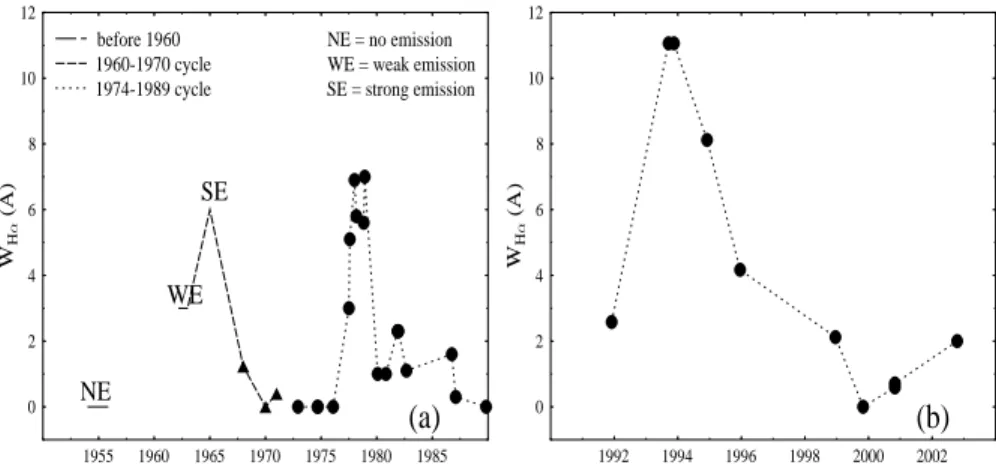HAL Id: hal-00008531
https://hal.archives-ouvertes.fr/hal-00008531
Preprint submitted on 7 Sep 2005
HAL is a multi-disciplinary open access
archive for the deposit and dissemination of
sci-entific research documents, whether they are
pub-lished or not. The documents may come from
teaching and research institutions in France or
abroad, or from public or private research centers.
L’archive ouverte pluridisciplinaire HAL, est
destinée au dépôt et à la diffusion de documents
scientifiques de niveau recherche, publiés ou non,
émanant des établissements d’enseignement et de
recherche français ou étrangers, des laboratoires
publics ou privés.
THE LONG-TERM Hα EMISSION LINE VARIATION
IN α Eri
M.M.F. Vinicius, Nelson, Vani Leister, Juan Zorec, Ronaldo Levenhagen
To cite this version:
M.M.F. Vinicius, Nelson, Vani Leister, Juan Zorec, Ronaldo Levenhagen. THE LONG-TERM Hα
EMISSION LINE VARIATION IN α Eri. 2005. �hal-00008531�
ccsd-00008531, version 1 - 7 Sep 2005
SF2A 2005
F. Casoli, T. Contini, J.M. Hameury, and L. Pagani (eds)
THE LONG-TERM Hα EMISSION LINE VARIATION IN α ERI
Vinicius, M.M.F.
1, Leister, N.V.
1, Zorec, J.
2and Levenhagen R.S.
1Abstract. The long-term variation of the Hα line in α Eri has 14-15 years
cyclic B⇀↽Be phase transitions. The disc formation time scales, interpreted
as the periods during which the Hα line emission increases from zero to its maximum, agree with the viscous decretion model. On the other hand, the time required for the disc dissipation ranges from 6 to 12 years which questions the viscous disc model predictions.
1 Introduction
Among the outstanding characteristics of Be stars are their phase B⇀↽Be⇀ ↽Be-shell transitions evidenced by the Balmer line emission intensity changes. These changes can be ought either to variations of the physical structure and size of a more or less permanent circumstellar envelope (CE), or to the creation of a new CE during mass ejection events that undergo the central star. Some keys on the CE formation can be obtained from the time scales of their emission line variation, which can be related directly with the disc formation. In this contribution we present the cyclic long-term Hα line emission changes observed in α Eri.
2 Cyclic long-term Hα line emission changes
We collected in the literature the spectroscopic and photometric records of the Hα line variation and studied them as a function of time. We also take advantage of new observations of the α Eri Hα line emission changes, to derive information on time scales that characterize complete B⇀↽Be transitions. The time scales of these cycles matter to understand the disc formation mechanisms (Porter 1999, Okazaki 2001).
If the evolution of the CE in α Eri, i.e. formation and subsequent dissipation, has to be understood in terms of a viscous decretion disc model (Porter 1999, Okazaki 2001), from the expected average viscous time scales t ∼ 60/α days (Clark
1 Instituto de Astronomia, Geof´ısica e Ciˆencias Atmosf´ericas da Universidade de S˜ao Paulo,
Brazil
2Institut d’Astrophysique de Paris, UMR7095 CNRS, Universit´e Pierre & Marie Curie
c
2 SF2A 2005
et al. 2003) we would derive two different series of values of the viscosity coefficient α. The time scales implied by the CE formation, 2 years roughly, we would obtain α ∼ 0.08 which is of the same order as expected for CE envelopes studied by Clark et al. (2003). The time required by the decrease from maximum to zero is either 10 years in the 1974-1989 cycle or 6 years during the 1991-2000 cycle. This imply 0.02 ∼ α<
<
∼ 0.03 which is about 4 times smaller than implied in the formation process. We may then wonder whether the bulk redistribution of material in the circumstellar disc occurs only as a consequence of a viscous redistribution of angular momentum.
3 Conclusion
The long-term Hα line emission variation in α Eri has a long-term, roughly cyclical B⇀↽Be phase transitions every 14-15 years. The disc formation time scale, i.e. period when the Hα line emission increases from zero to its maximum, agrees with the viscous decretion model. On the other hand, the time required for the disc dissipation ranges from 6 to 12 years, which may question the viscous disc model.
1955 1960 1965 1970 1975 1980 1985 0 2 4 6 8 10 12 W H (A) 1974-1989 cycle 1960-1970 cycle before 1960 NE WE SE
(a)
SE = strong emission WE = weak emission NE = no emission 1992 1994 1996 1998 2000 2002 0 2 4 6 8 10 12 W H (A)(b)
Fig. 1. Long-term variation of the Hα line emission in α Eri. (a): Qualitative and
quantitative estimations of the emission strength before 1990 collected in the literature. (b): New equivalent widths of the Hα line emission obtained after 1990. Different markers were used to identify the emission cycles better.
References
Clark, J. C., Tarasov, A. E., & Panko, E. A. 2003, A&A, 403, 239 Okazaki, A. T., 2001, PASJ, 53, 119
